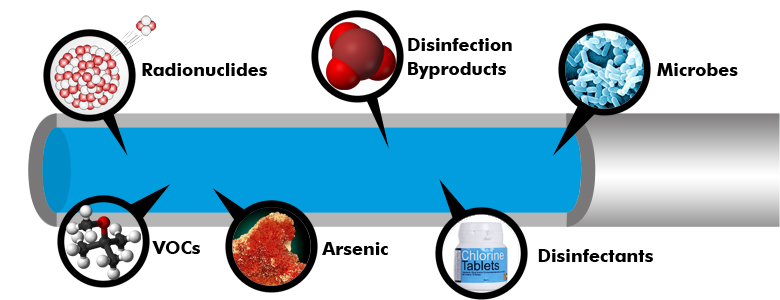
Most Common Water Contaminants Index Page
Drinking water, including bottled water, may reasonably be expected to contain at least small amounts of some contaminants. U.S. EPA sets standards for approximately 90 contaminants in drinking water. Contaminants are categorized as below and more detailed information on specific contaminants is also available.
Microbes ~ Radionuclides ~ Inorganics ~ Volatile Organics ~ Disinfectants ~ Disinfection Byproducts ~ MTBE

Microbes
Fecal Coliform and E coli are bacteria whose presence indicate that the water may be contaminated with human or animal wastes. Microbes in these wastes can cause short-term effects, such as diarrhea, cramps, nausea, headaches, or other symptoms.
Cryptosporidium is a parasite that enters lakes and rivers through sewage and animal waste. This microbe has an outer shell that allows it to survive outside the body for long periods of time which makes it tolerant to many chlorine disinfectants. It causes cryptosporidiosis, a mild gastrointestinal disease. However, the disease can be severe or fatal for people with severely weakened immune systems. EPA and CDC have prepared advice for those with severely compromised immune systems who are concerned about Cryptosporidium.
Giardia lamblia is a parasite that enters lakes and rivers through sewage and animal waste. It causes gastrointestinal illness (e.g. diarrhea, vomiting, cramps). Giardia, like cryptosporidium, can survive long periods of time outside the body and is also difficult to treat with just basic chlorine disinfectants.
Coliform bacteria are common in the environment and are generally not harmful. However, the presence of these bacteria in drinking water is usually a result of a problem with the treatment system or the pipes which distribute water. This indicates that the water may be contaminated with germs that can cause disease.
Turbidity has no health effects. However, turbidity can interfere with disinfection because the particles can act as shields for viruses and bacteria and provide a medium for microbial growth. Turbidity may indicate the presence of disease causing organisms. These organisms include bacteria, viruses, and parasites that can cause symptoms such as nausea, cramps, diarrhea, and associated headaches.
Radionuclides
Alpha emitters. Certain minerals are radioactive and may emit a form of radiation known as alpha radiation. Some people who drink water containing alpha emitters in excess of EPA's standard over many years may have an increased risk of getting cancer.
Beta/photon emitters. Certain minerals are radioactive and may emit forms of radiation known as photons and beta radiation. Some people who drink water containing beta and photon emitters in excess of EPA's standard over many years may have an increased risk of getting cancer.
Combined Radium 226/228. The total amount of radium allowed in drinking water is very small. However, people that drink water containing radium 226 or 228 in excess of EPA's standard over many years may have an increased risk of getting cancer.
Radon gas can dissolve and accumulate in underground water sources, such as wells, and in the air in your home. Breathing radon can cause lung cancer. Drinking water containing radon presents a risk of developing cancer. Radon in air is more dangerous than radon in water.
Read Next: Health Risks of Heavy Metals





